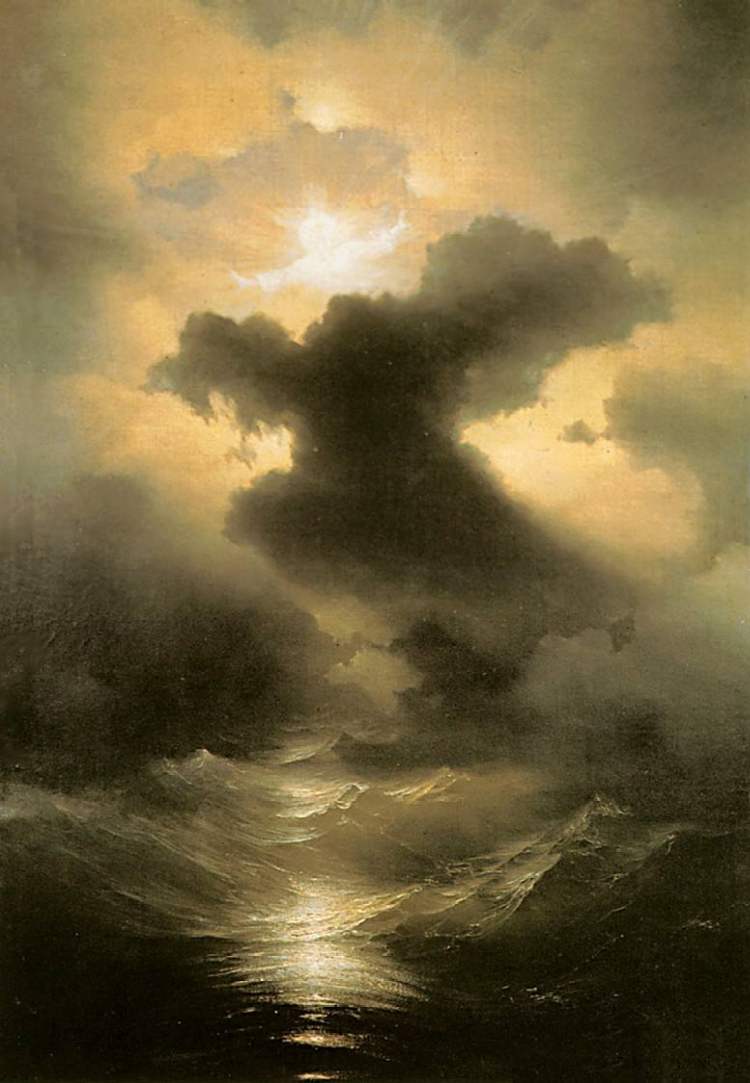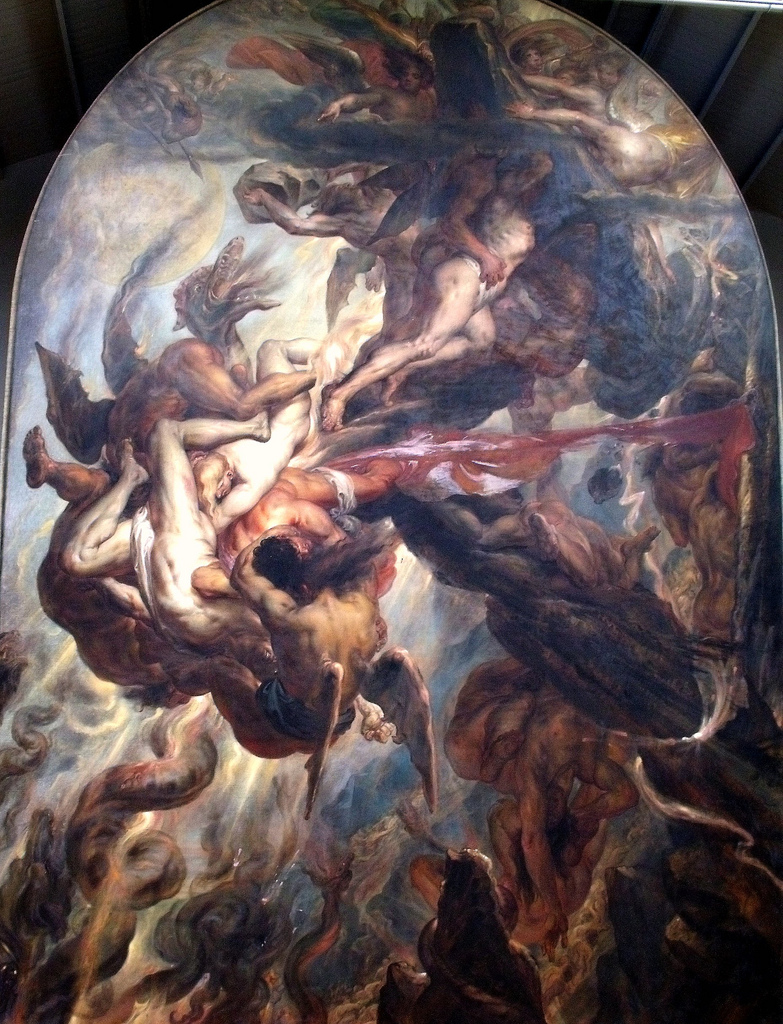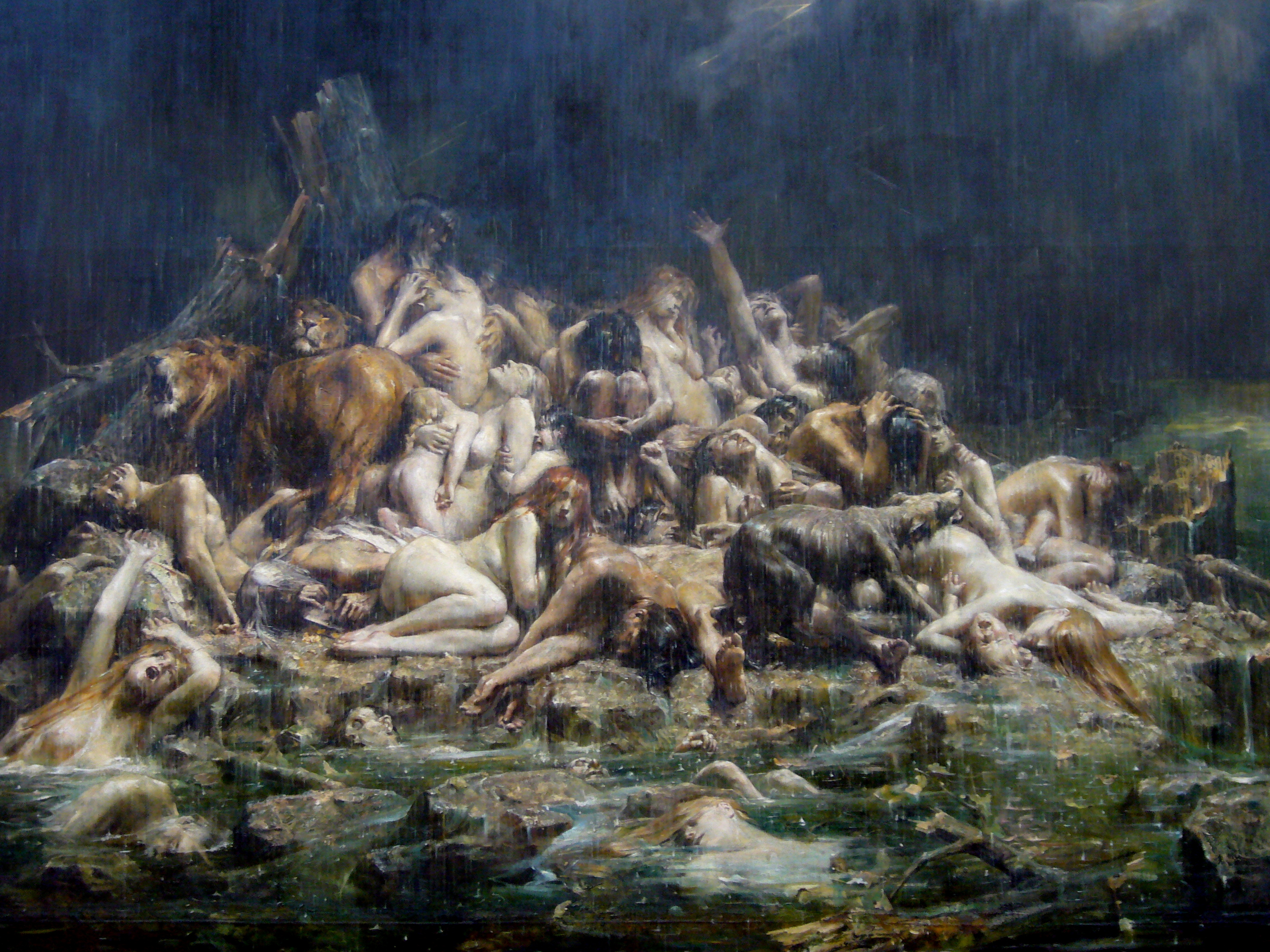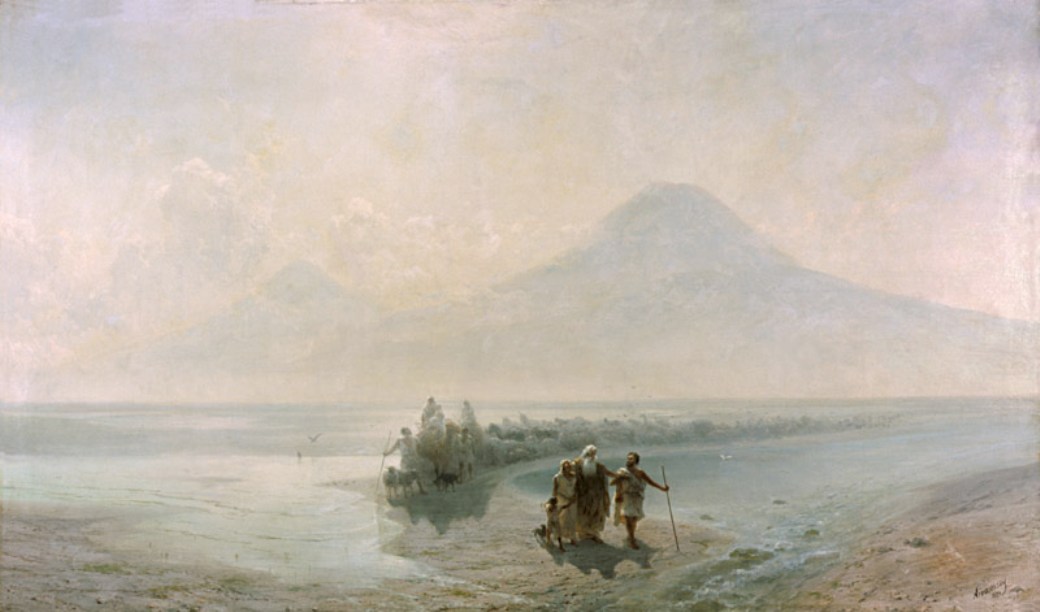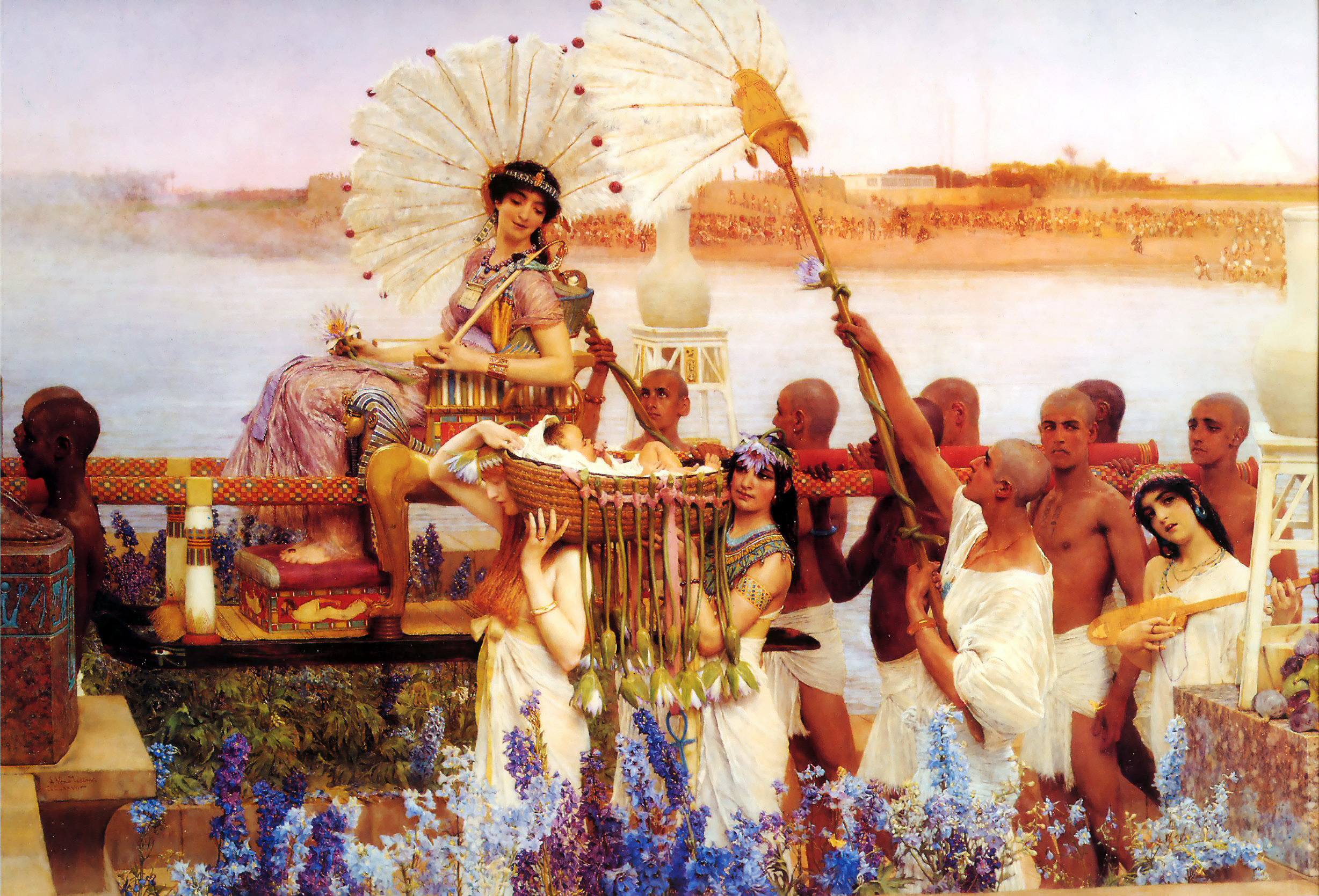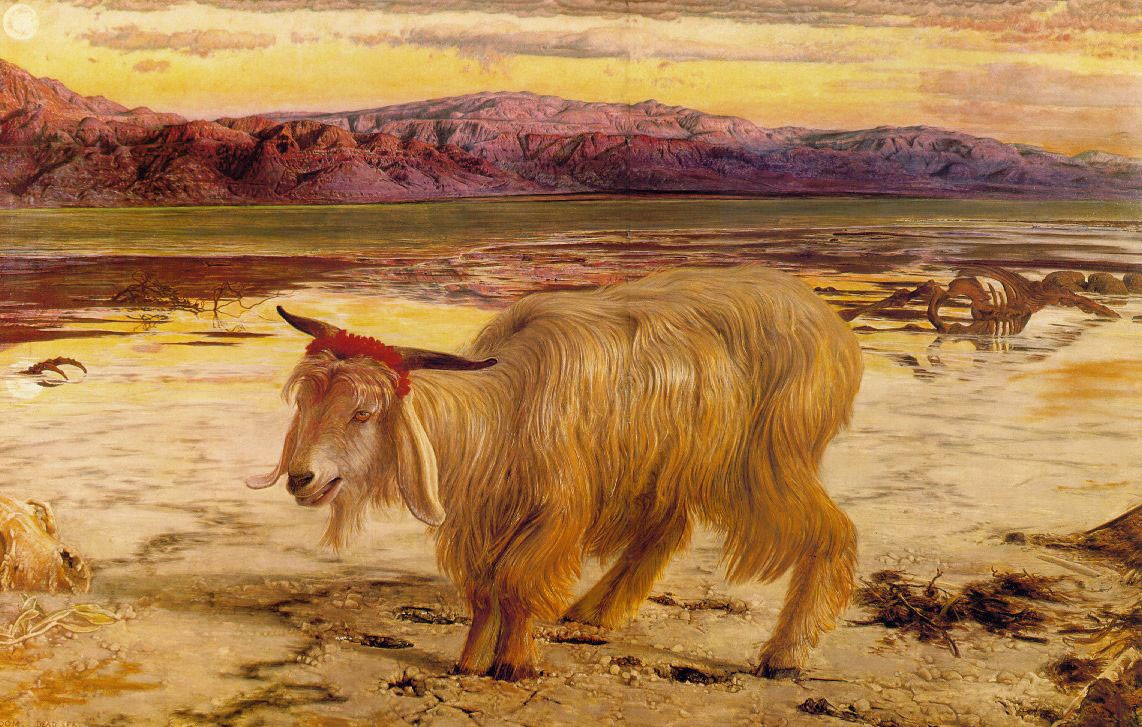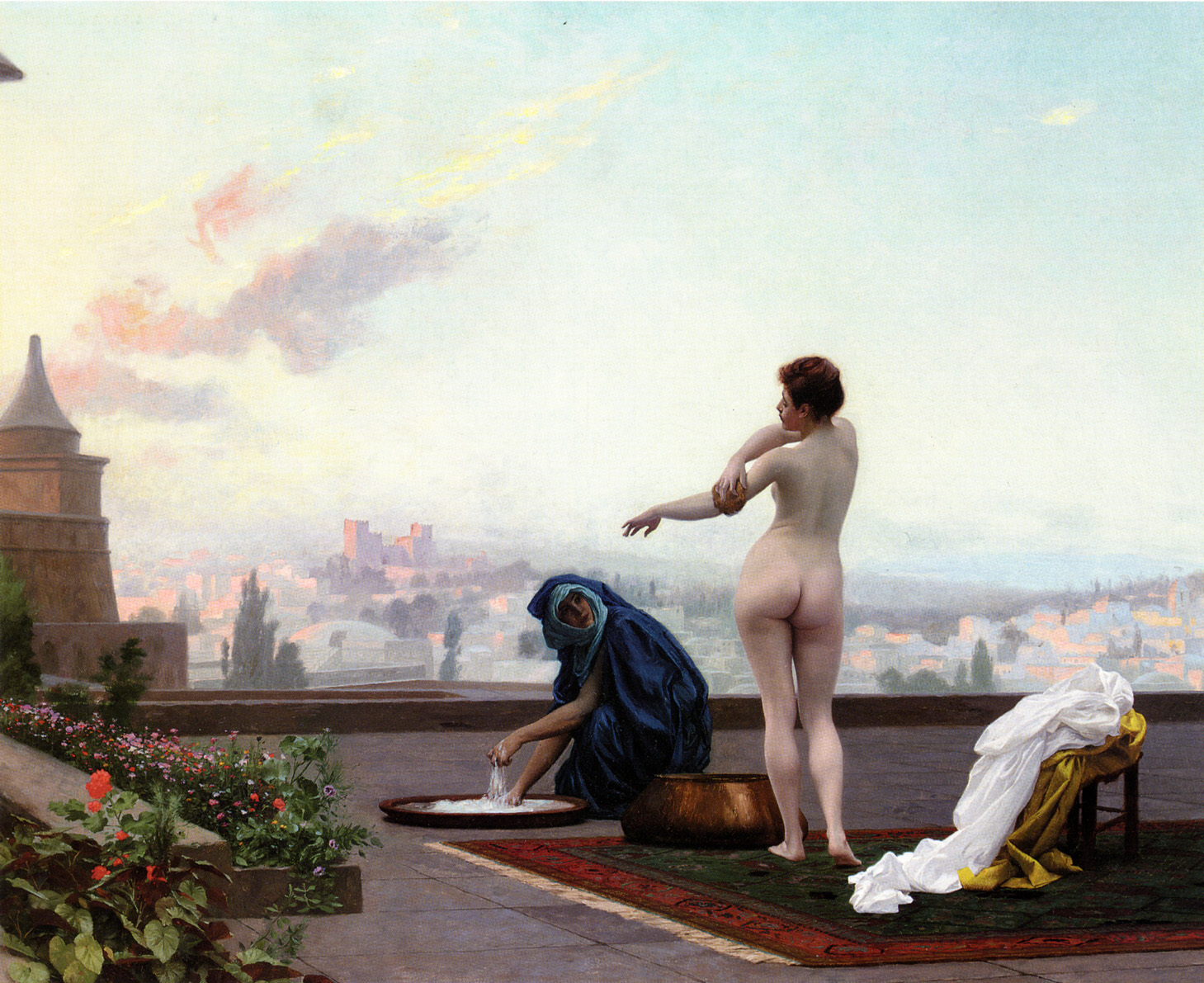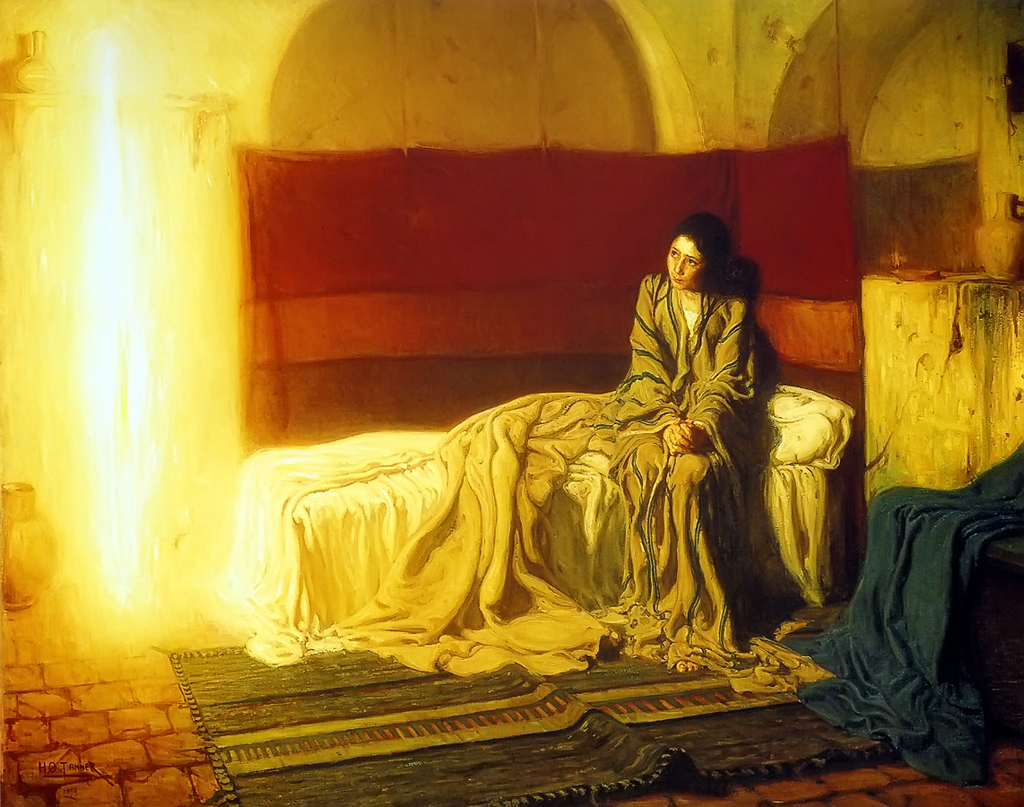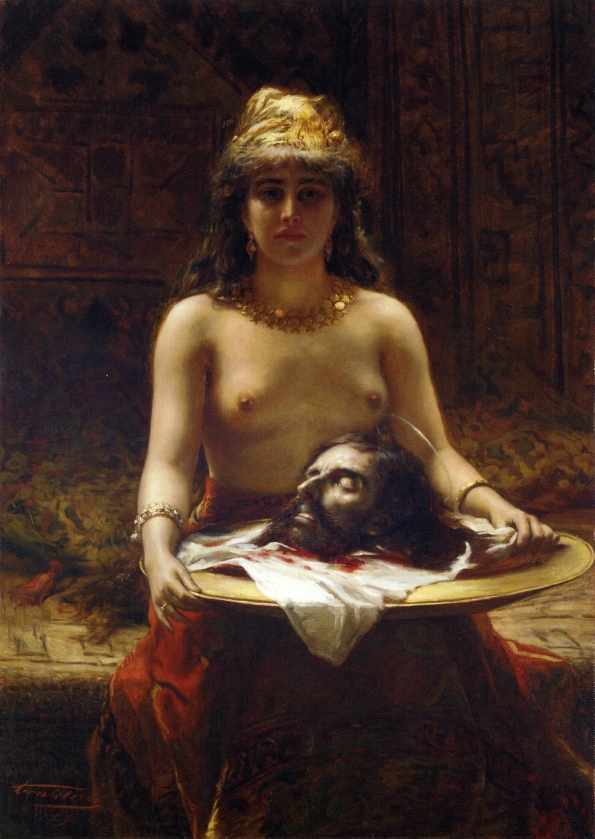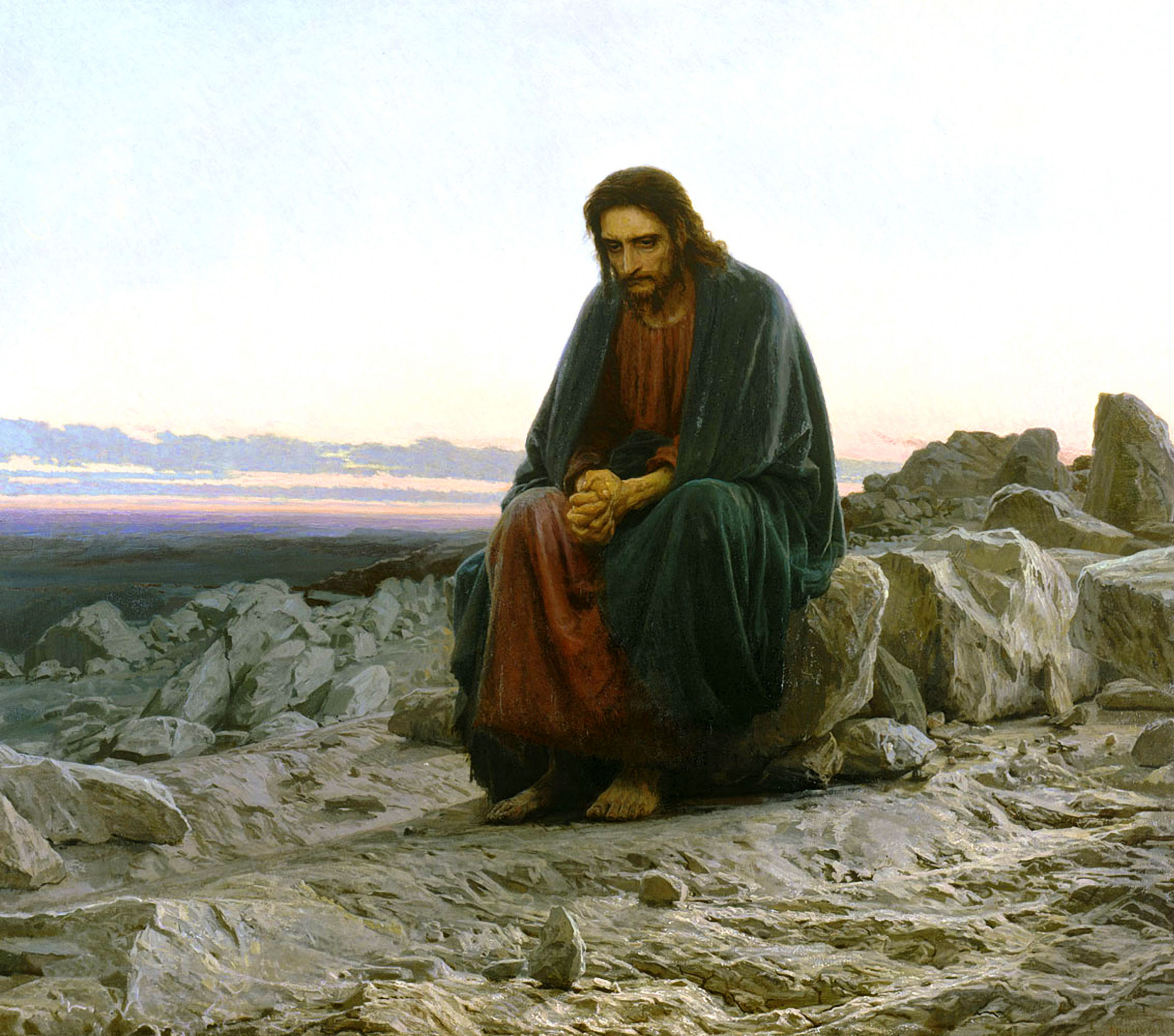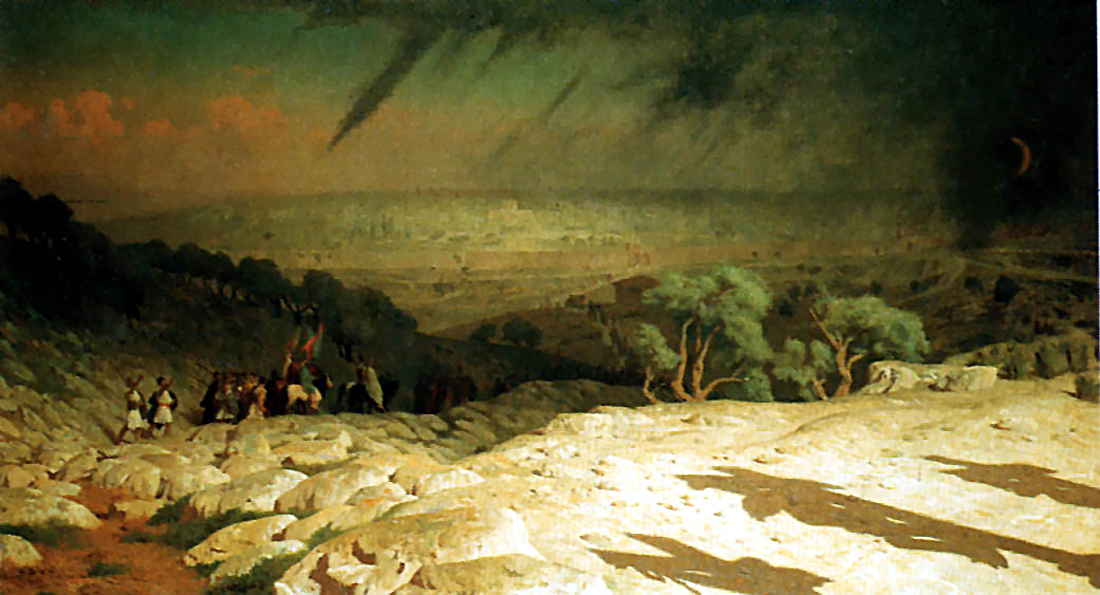This guided tour will focus on the biblical story through the eyes of 19th century painters. Not restricted by rules of the church regarding subject choice and in a time where the biblical Palestine was rediscovered, the visual language changed to tell an old story in new clothes.
We will start at the very beginning : the creation of the world.
Chaos, Ivan Aivazovski, 1841
Aivazovski, the famous Armenian seascape painter made this impression of the primordial sea where the spirit of God hovered over the dark waters as the only illumination (because the sun had not been created yet).
Some place in time God had created angels. Powerful servants. But some of them wanted to be free and on their own. This resulted in a war in which the rebellious angels were thrown out of the heavens. The following painting from Wiertz illustrates this fight.
Antoine Wiertz, La révolte des Enfers contre le Ciel : La chute des anges, 1842
Within this reality, God had created the world and its inhibitants and he had made it excellent. Everything was in balance and God enjoyed his creation and made human beings to fill the earth and care for it.
And we all know what happened next. But just moments before Eve took a bite of the apple, Gustave Surand painted here in a flower-rich field riding an elephant. Everything still breathes a joyful serenity filled with innocence.
Gustave Surand, Eve dans l’Eden, 1932
When the first humans disobeyed God, death entered the world as a punishment for sin. Cain murdered his brother Abel and Bougereau catches the moment when Adam and Eve find their murdered sun. The grief and pain are intense. It was only after Bougereau lost his own son, that he was ready to make this painting.
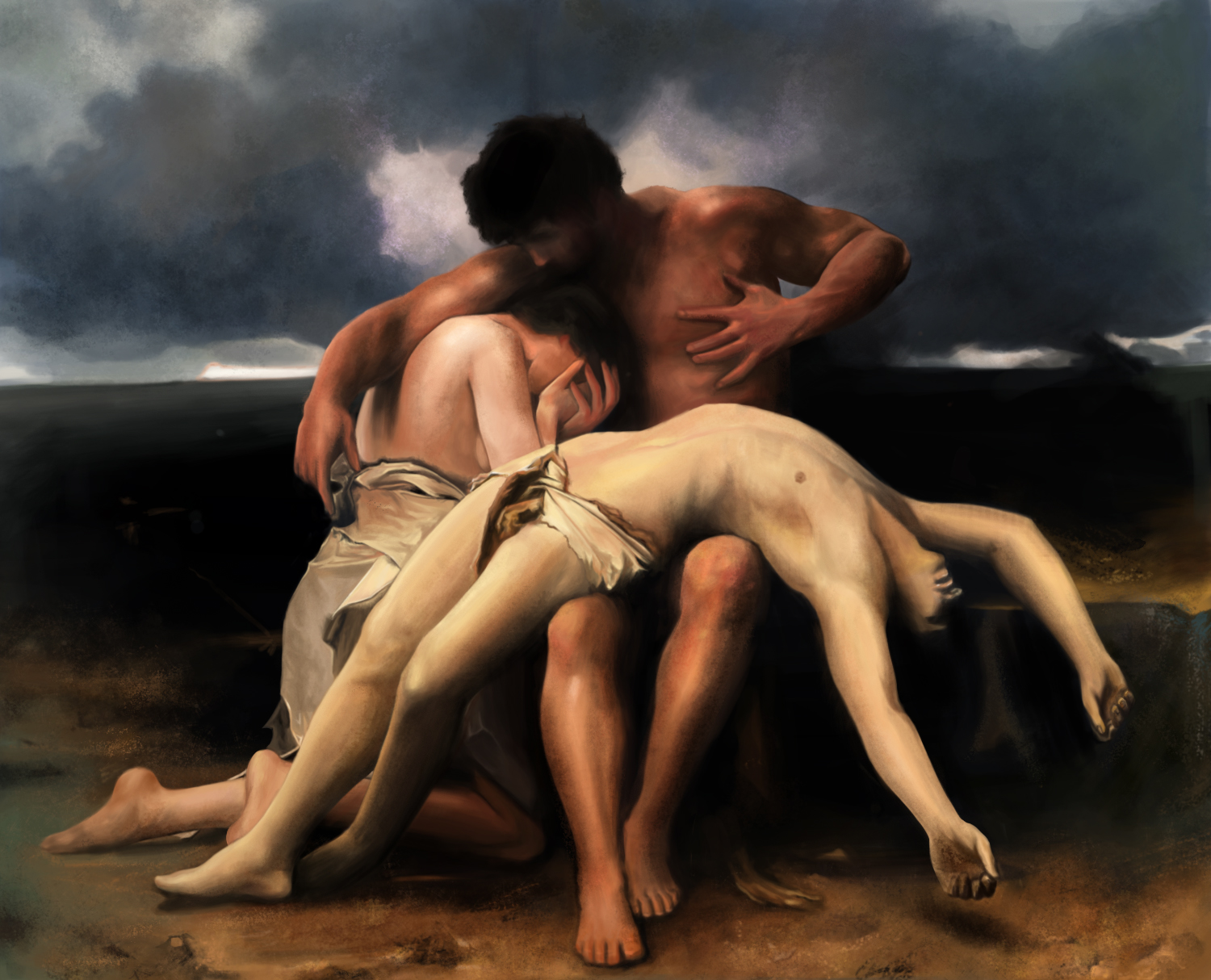 First mourning, William Adolphe Bougereau, 1888
First mourning, William Adolphe Bougereau, 1888
This first mourning was not the last of the human race. Led by their selfish ego’s people tried to raise themselves at the expense of others. A world full of sin had emerged. But this was not the world God had aimed for. And in the end, death is the price of sin. God decided to terminate all his creatures. He send a flood. But not before he appointed Noah, his family and a selection of animals to be rescued. All the others perished. Comerre made this impressive canvas were the rain does not stop and utter despair is palpable.
Le Deluge, Leon Francois Comerre, 1911
When the flooding ended and the waters retreated, Noahs rescue vessel, the ark, landed on the top of a mountain. The people and the animals disembarked to start a new future.
Dejection of Noah from mountain Ararat, Ivan Aivazovski, 1889
The people of God spread over the world. The mighty civilisations of Mesopotamia and Egypt ruled the world. But God showed how he used the weak and the poor to be his powerful servants, even defeating Pharaoh. The child of a slave, Moses, destined to be drowned in the Nile, was adopted by the royal Egyptian family, later to become the leader of his people and to free them from slavery.
The finding of Moses, Lawrence Alma-Tadema, 1904
Gods people went to Canaan, their promised country. And God went with them. He told Moses to make a tent for him and to appoint priests to perform ceremonial sacrifices to cover for the sins of the people. Each year, a special sacrifice was made, in which a goat, bearing the sins of the people and tied with a red band on its horns, was sent away in the wilderness. William Holman Hunt travelled to the dead sea to immerse himself in the landscape, and painted his scapegoat.
The scapegoat, William Holman Hunt, 1854
After many fights and quarrels, Canaan was finally inhabited by Gods people. But being Gods people was not enough. While God provided judges, the people wanted a king. And God agreed. As Saul was the first king, his successor David became a more iconic king who nevertheless showed that kings are no different to normal people and susceptible to seduction. The great orientalist painter Gerome transforms a harem scene to the roof of a building, telling the story of Batseba who unwillingly seduced king David while bathing on the roof.
Bathsheba, Jean-Leon Gerome, 1899
The kings of Israel did not last for long. The kingdom first broke up into two pieces and was later defeated by Assyria and Babylonia and taken into exile. The royal princes among which Daniel, were taken to the Babylonian court to serve the king. But Daniel hold true to his service to God an refused to stop praying. For this he was sentenced to death and put in a lion’s den. Briton Riviere who liked to paint animals, painted the miraculous scene were Daniel survived the ordeal.
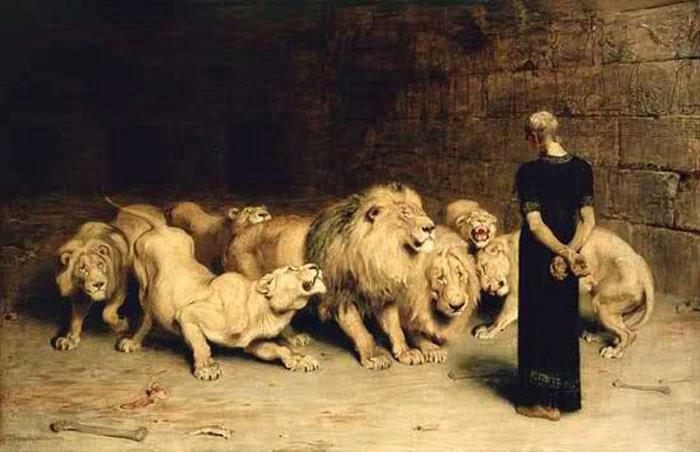 Daniel in the lions den, Briton Riviere, 1872
Daniel in the lions den, Briton Riviere, 1872
Although the Persian king Cyrus gives permission to the Jews to return to Jerusalem and rebuild their temple, their very existence as a nation is being threatened during the reign of another Persian King, Xerxes. Married to the winner of a beauty contest, he does not know that his wife is Jewish. And when queen Esther realises that the life of her people is at stake by a complot, she identifies herself to the king as a Jew. Millais portraits her at a defining moment when Esther makes her uninvited entrance to the king, something that she could be killed for.
Esther, John Everett Millais, 1865
Ruled by foreign kings, the Jews put strength from the message of their prophets : God would set his people free again by the coming of the Messiah. And it was in the small village of Nazareth that the angel Gabriel came to Mary to announce the birth of Jesus. Henry Ossawa Tanner made a 19th century annunciation in which Mary, her blue robe tossed aside, listens to the angel.
Annunciation, Henry Ossawa Tanner, 1898
King Herod ruled Palestine and was known for his mistrust. Even his own familymembers were killed when he suspected them from threatening his position and throne. When he heard of the birth of a new king in Bethlehem, he gave orders to kill all the local male infants. This horrible infanticide was visualised by Leon Cogniet in which the fear of the mother is central to the painting.
Massacre of the innocents, Leon Cogniet, 1824
One favourite biblical theme in classical painting is the beheading of John the Baptist. There are numerous Salome’s who share the same ingredients : blood and lust. The severed head is presented in a bowl or on a plate and Salome transformed in a mysterious oriental dancer. The Belgian painter Leon Herbo made his own version.
Salome, Leon Herbo, 1889
Trained at the academy, Ivan Kramskoi chose to join the Russian Wanderers movement. With his masterful academic technique he painted Christ in the desert. Instead of a glorious leader, we see a barefoot exhausted man with sunken eyes contemplating in the cold desert. Truly a man of sorrows.
Christ in the desert, Ivan Kramskoi, 1872
At the end of his tour through Israel, Jesus went to Jerusalem. Preparing for his imminent death, he had a final meal with his followers and retreated on a nearby hill with his close friends to await his betrayal and arrest. In this Gethsemane olive garden, he prayed to his father for strength. This scene is illustrated by the Danish Carl Bloch as one of the paintings he made for the restauration of the chapel of Frederiksborg castle. Left alone by even his closests friends, Bloch paints an angel from God to give comfort in this dark hour.
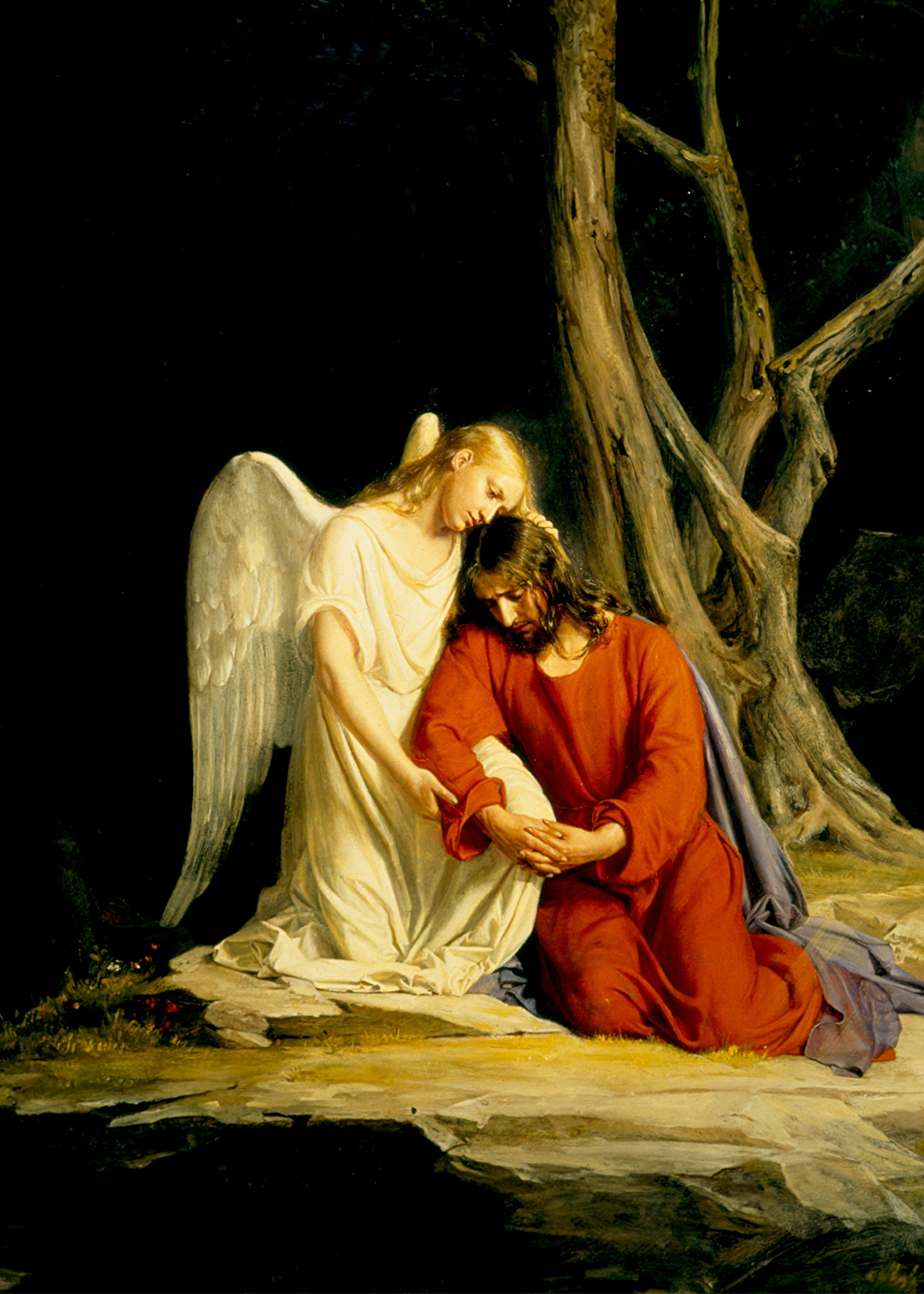
Gethsemane, Carl Heinrich Bloch, 1875
The path of Jesus leads to the cross. Being the most illustrated scene in the life of Christ, some artists chose a different angle of view. Jean Leon Gerome depicts the crucifixion scene by painting the shadow of the cross. While the people return to Jerusalem and the sun carves sharp shadows on the foreground, the darkness invades from the background to complete the isolation of Jesus. And only when his suffering was completed, Jesus could die and speak his last words : it is completed (consummatum est).
Consummatum est, Jean Leon Gerome, 1867
However, this would not be the last words of Jesus. After the Jewish sabbath on the first day of the week, Jesus rose from the dead. And he spoke with his disciples again. But things had changed. Jesus was still present among the disciples and although they could eat with him and touch his wounds, he was no longer confined to places and human boundaries. One moment he was among them, the other moment he disappeared. What remained was his promise: I will stay with you.
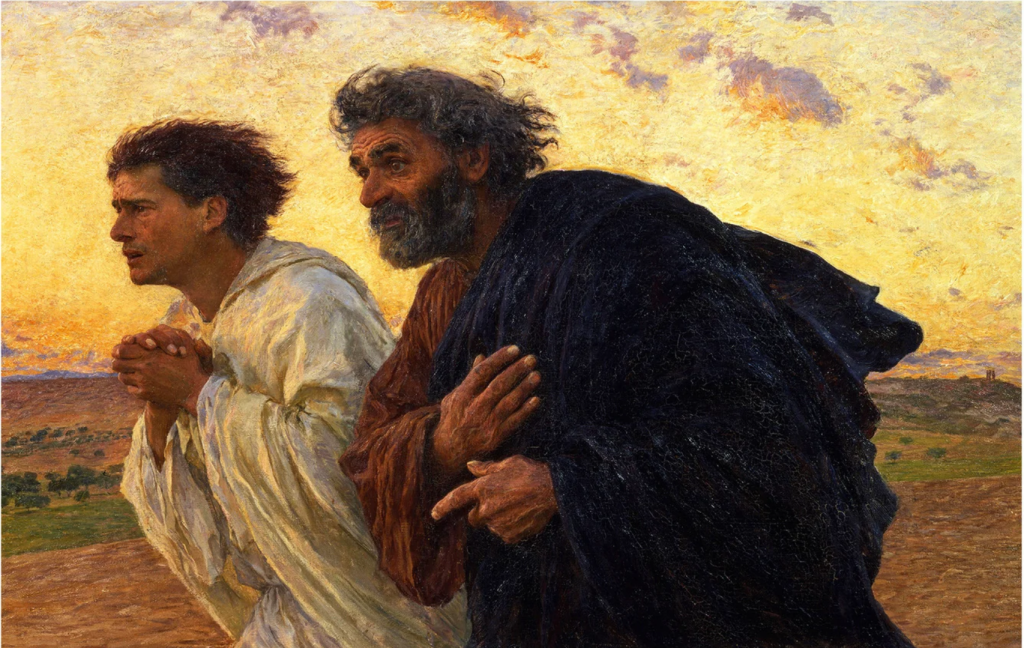
The Disciples Peter and John Running to the Tomb on the Morning of the Resurrection
Eugène Burnand,1898
On this painting of Eugene Burnand, a Swiss painter, the disciples Peter and John are running towards the tomb of Jesus. They could not believe the news that they had heard: Jesus was alive. Their faces speak volumes. If this would be true, it would be life changing. And the rest of their lives would be at the service of spreading this good news throughout the world.
Later that day two other disciples met the resurrected Jesus. This was illustrated by Caravaggio in his “Supper at Emmaus”. Although Caravaggio is not a 19th century painter, he was the forerunner of realism and ahead of his time in his mastery of light and dark. Caravaggio depicts the resurrected Jesus in a new body. Without beard and without a halo. Instead he has shadows as an anti-halo and on the tablelinnen the fruit basket casts a particular shadow in the form of a fish tail, the Christian Ichtus symbol.
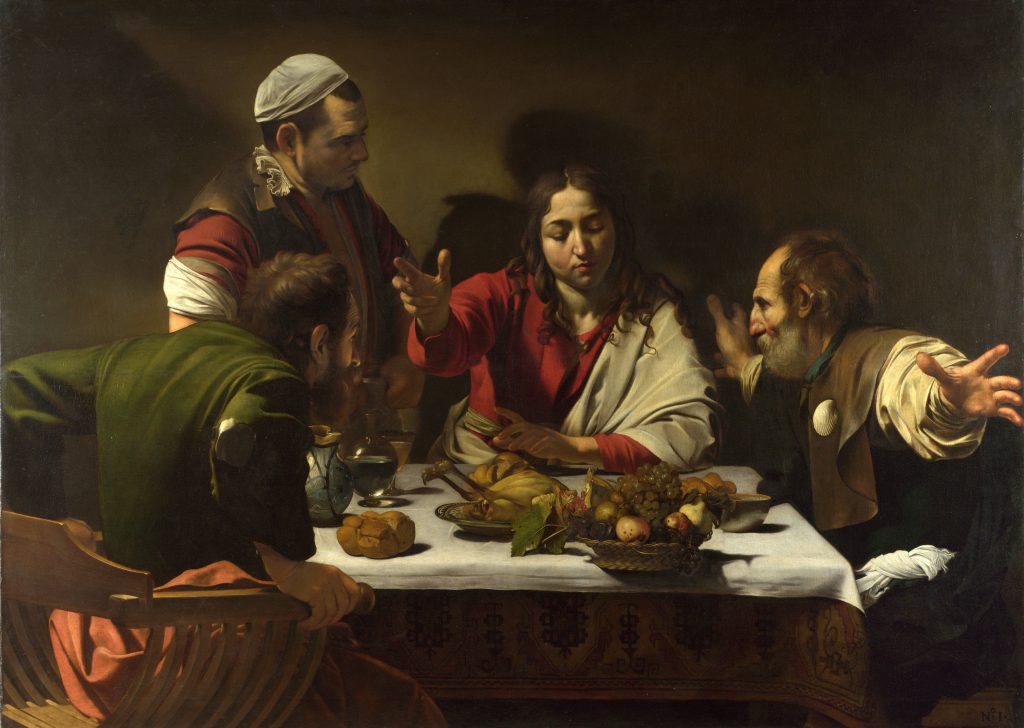
Supper at Emmaus, Caravaggio, 1601

